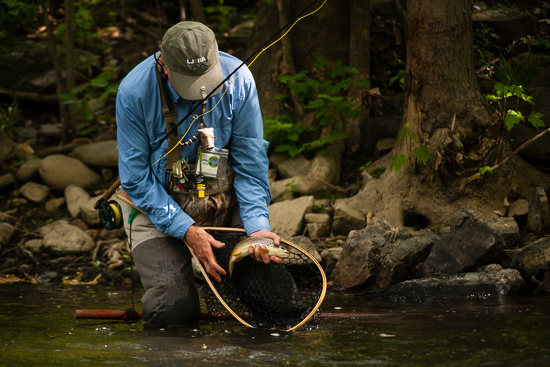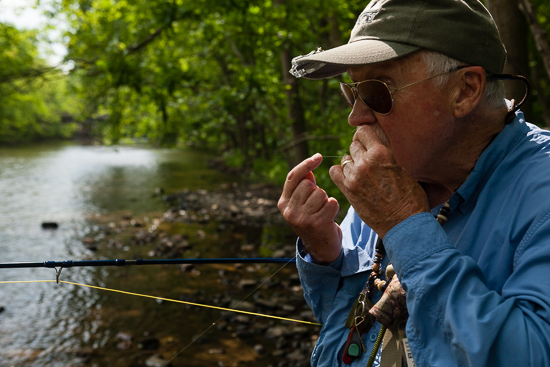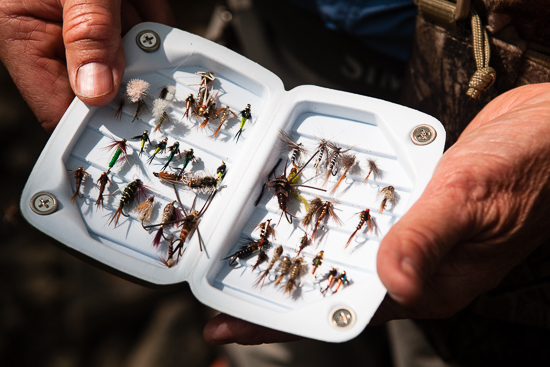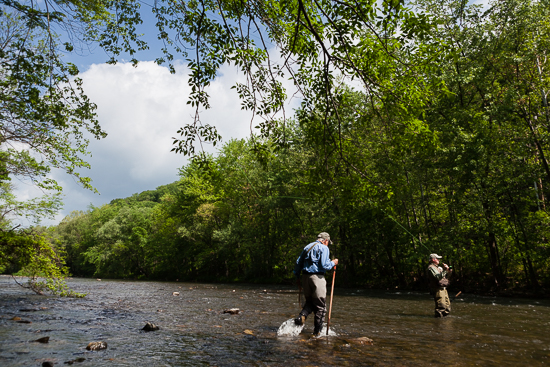From 'open sewer' to Class A trout stream
How a local river association helped bring the Little Juniata back to life
As the clear, cold waters of the Little Juniata River rush through the forests and farmland of central Pennsylvania, hidden spring holes and rocky boulders provide hideaways for the cautious brown trout. Above water, Bill Anderson is teaching longtime friend John Norton the basics of fly fishing, in the hopes of catching one of these popular sport fish. “Fly fishing provides a means to get to be in nature as a participant instead of a spectator,” Anderson describes. “You’re there actively seeking a target, in this case the trout. And there’s something very primal and addictive about the infrequent benefit that comes from standing in cold water and tossing a fly at a spot on the water where you think a fish is going to take it.”
The Little Juniata—or “Little J”—is a sanctuary for fly fishermen on the East Coast. Little-known to outsiders, it attracts fishermen from across the region who hope to catch brown trout in its cool waters. But just a few decades ago, fishing in the Little Juniata River seemed unthinkable. “Well, the Little Juniata River is not well-known nationally, primarily because it’s only been a trout stream since around 1975,” Anderson says. “The reason being that prior to that it was literally an open sewer.”

A long history of pollution from municipal sources, nearby tanneries and a paper mill had degraded the river into what Anderson calls a “dead stream.” And after a mysterious pollution event in 1997 destroyed much of the waterway’s aquatic insect and invertebrate population—essentially starving the brown trout—the community had had enough. “We never determined the cause. But several local people got together who loved the river and decided that wasn’t going to happen again,” says Anderson, current president of the nonprofit organization that emerged: the Little Juniata River Association (LJRA).

For a handful years after its foundation, the LJRA sat dormant: most of the few dozen members had drifted away and meetings were infrequent. But in the decade since Anderson became its president, the group has transformed nearly as much as the river itself. The purely-volunteer organization now boasts more than 200 members, and its mission includes not just monitoring of the river, but the improvement of the whole watershed. Activities range from restoring stream banks to protecting fish habitat. More than 1,400 feet of stream bank has been repaired to prevent excess sediment from entering the river, where it can block sunlight from reaching underwater plants and smother bottom-dwelling species. The nonprofit also hosts an annual trash pick-up, clearing 20 miles of riverbank of litter and debris.

These days, the LJRA is focused on the future. With changing climate conditions come rising water temperatures, which can be devastating for the health of cold-water fish like brown trout. In association with Juniata College, the LJRA tagged 24 mature trout to determine where the fish go when water temperatures warm. “The idea is let the trout lead us to the places that need to be improved, and then we’ll set about improving those pieces and parts of the river, whether for spawning or for refuge from heat,” Anderson explains.

Just as important to Anderson as the health of the trout is the opportunity for others—like his friend Norton—to fish for them. In recent years, private fishing clubs have purchased and leased land along the river, requiring expensive memberships for fishermen to access the stream. But with help from the Pennsylvania Fish and Boat Commission, the LJRA has worked with landowners to establish more than five miles of permanent public fishing easements. “We’re not done,” says Anderson. “We won’t be done until all 32 miles of river are permanently publicly accessible. We want to make sure this resource stays open for our children and grandchildren.”
To view more photos, visit the Chesapeake Bay Program’s Flickr page.

Comments
Wonderful story and photos... thanks for sharing! Love the idea of letting the fish 'lead the way' to the places they need us to restore/protect.
Thank you!
Your comment has been received. Before it can be published, the comment will be reviewed by our team to ensure it adheres with our rules of engagement.
Back to recent stories